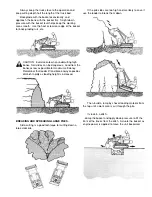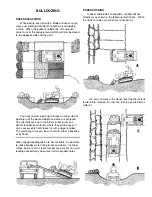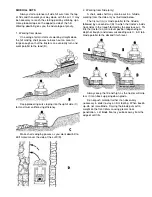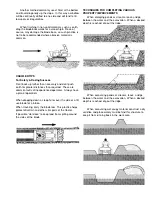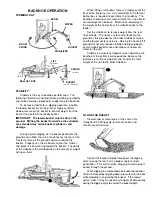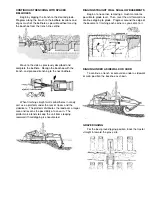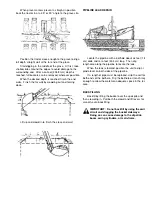
TRACKED VEHICLE OPERATION
A Tracked Vehicle, by its very nature, is a vehicle
requiring a great degree of care and judgment during
operation. It should be kept in mind that while your
Tracked Vehicle is designed to operate in rough terrain,
this same fact allows for the possibility of a hazardous
condition developing at any time. Safe operation of your
Tracked Vehicle must be based on the understanding of
the vehicle’s limitations, thorough knowledge of the
controls and their functions, and the operator’s good
judgment and experience.
SAFETY WARNING: WHERE THE OPERATOR
IS NOT CERTAIN OF THE VEHICLE’S ABILITY
TO TRAVERSE AN OBSTACLE OR TERRAIN
SITUATION, OR, IS NOT CERTAIN OF HIS
OWN ABILITY TO SAFELY OPERATE THE
VEHICLE, AN ALTERNATE ROUTE MUST BE
TAKEN.
OPERATION ON SLOPES
Tracked Vehicle operation on slopes presents an
obvious opportunity for the vehicle to tip over. This type
of operation demands constant attention to changes in
terrain and the ability to anticipate and avoid possible
hazards.
This ability can only be developed through careful
study of the points noted in this section and a slow,
planned effort on the operator ’s part to become proficient.
The most effective guard against hazards while
operating on slopes, especially during downhill operation
is to keep vehicle speed very slow.
SAFETY WARNING: WHEN OPERATING ON
SLOPES VEHICLE SPEED SHOULD BE KEPT
VERY SLOW AND THE OPERATOR SHOULD
BE EXTREMELY ALERT FOR CHANGES IN
TERRAIN.
Vehicle stability on a hill, for example, is determined
not only by the general slope of the hill but also by terrain
conditions (rocks, ditches,, logs, drop-offs, etc.) and by
the nature of the hill surface (gravel, sand, grass, snow,
rock, etc.), the payload which the vehicle is carrying, the
manner in which the payload is distributed within the
vehicle, attachments and accessories which have been
added to the vehicle, and so forth.
Similarly, driving technique and its effect on vehicle
stability enters into any determination of what constitutes
a safe slope. Excessive speed, sudden braking, choice
of path - all can be critical.
UPHILL OPERATION
The following illustrations depict some situations in
which a Tracked Vehicle can be expected to tip over.
Variations in speed, loading, terrain and vehicle condition
must all be analyzed to determine whether or not a
specific obstacle can be traversed. If in doubt, do not
attempt.
SAFETY WARNING: ON STEEPER SLOPES
SMALLER OBSTACLES WILL CAUSE A TRACKED
VEHICLE TO TIP OVER.
It is common to see a situation where a natural
erosion has caused the very top of a bank or hill to rise
sharply. Always check for this condition before attempting
to climb any such type of terrain. A Tracked Vehicle could
climb up to a point at which it falls over backward.
It is also very important to check for this terrain
condition before going down over the edge of a bank or
dropoff.
The same situation can occur where an embedded
object is pulled from the ground. The vehicle track may
‘grab’ a rock or log. As the object emerges from the
ground, rolling under the track, the vehicle could climb to
the point at which it falls over backward.





















